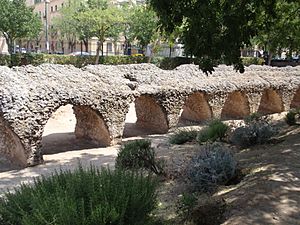Roman circus of Toledo facts for kids
The Roman circus of Toledo was a huge arena in ancient Toledo, Spain. It was like a giant stadium where people watched exciting chariot races. Back then, Toledo was called Toletum, and it was part of a Roman area called Hispania.
Contents
History of the Toledo Circus
The Roman circus in Toledo was built a very long time ago, in the 1st century AD. This was when emperors like Augustus or Tiberius ruled the Roman Empire. They wanted to build big public places in all major cities. This included amphitheatres, theatres, fora (public squares), and thermae (bathhouses).
These buildings helped spread Roman culture and ideas. The circus in Toledo was built just outside the main city walls. This was common because circuses were so big! People likely used a special road to get from the city to the circus, but we haven't found it yet.
Other Roman Entertainment Spots
Right next to the circus, there was another fun place: a Roman theatre. Today, sports fields are on that spot. We know the theatre was there from old records. It's possible that parts of the theatre, like the stage or first seats, are still buried underground.
There was also a Roman amphitheatre in a different part of Toledo. Not much is known about it. Sadly, its remains were destroyed in the early 1900s to make way for new buildings.
What We've Learned from Archaeology
Archaeologists have not dug up the whole circus yet. More than half of it is still underground! But by comparing it to other Roman circuses in Spain, like the one in Mérida, we can guess its size.
The Toledo circus was about 422 meters (1,385 feet) long and 112 meters (367 feet) wide. It could hold between 15,000 and 30,000 people. This shows that Toledo was a very important city in Roman times.
We don't think the Toledo circus was used for naumachia, which were fake sea battles. Some other circuses, like the one in Tarraco, did host these.
Decline and Later Uses
The circus started to be used less when Christianity became popular. Christians often did not like these kinds of public events. When the Visigothic people took over, the circus was finally abandoned.
After that, people started taking the large sillar (cut stone blocks) from the circus. They used these strong granite stones to build other things. This continued for a long time, through the High Middle Ages.
During the time of the Muslim rule in Spain, the circus stands were used by merchants. They set up their shops there. Later, the Arabs used the circus as a cemetery. You can still see many signs of this old cemetery today.
In the Late Middle Ages, people stopped taking stones from the circus. The buildings were left alone outside the city. This meant they got buried over time, and people in Toledo forgot where they were.
Today, there are no plans to dig up the theatre or amphitheatre. However, there is a plan to explore the Roman circus more fully. The goal is to uncover it completely and create an amazing archaeological park for Roman Toledo.
See also
 In Spanish: Circo romano de Toledo para niños
In Spanish: Circo romano de Toledo para niños
- Hippodrome – a Greek arena also used for chariot racing


